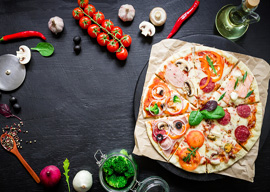
November 09, 2017

Source: Bigstock
I could use hundreds of other examples, but let’s move a few miles to the north, to Greenville, South Carolina, where I landed a couple weeks before Orlando. The restaurant in question here—popular, trendy, celebrated—is The Lazy Goat. Same menu format, with one exception: They do capitalize the entrées. And so we have…
House Made Beet Tagliatelle: asparagus, lacinato kale, white wine, fresno chilies, picked herbs, ricotta salata
House Made Beet Tagliatelle is 21.
So many questions. So many avenues of inquiry to go to here. Just a sampling:
How does “house made” differ from “homemade”?
How can the Italian pasta tagliatelle be made out of beets?
What the hell is lacinato?
Why is everybody selling kale all the time? Is there an oversupply of kale in Mendocino County?
Do the chilies really come from Fresno?
Does the word “chilies” mean chili peppers?
Is “picked” a typo? Do you mean “pickled”? Because “picked herbs” would be a “duh” moment. Yes, we know somebody had to pick the herbs.
Is “ricotta salata” a salad made out of cheese? And why did you transition into Italian after we were just in Fresno?
Notice that I’m limiting myself to descriptions of the actual ingredients. There are also a host of boastful statements on the menus assuring us that all the food is either “locally sourced” or “fair trade.” What if I’m dining next to the Superfund site in Camden, New Jersey? I don’t want any local sourcing. What if I’m in Minneapolis in January and I want an orange? Do you have a giant hydroponic greenhouse out back, large enough for orange trees, like the biosphere they’re building for the colonization of Mars? Also, since we’re drinking this French-press Viennese-style coffee from Somalian beans, could I take a look at those contracts your Mogadishu lawyer drew up with the surviving growers? I just wanna make sure it’s fair trade.
I’m not sure how this started, why it started, who keeps it going, but obviously there are some restaurant consultants out there inventing concepts like “dirty orzo,” “compressed seabeans,” and “muddled blueberries.” (Do they hand the blueberries to a 2-year-old before serving them?)
And yet if you go to what is considered the best restaurant in the United States—I haven’t been there because I’m not important enough to get a reservation or rich enough to pay for it—you have no menu at all. At Eleven Madison Park in New York they just tell you “eight to ten courses” (thanks for narrowing it down), so when you get there they assume you’ll be overwhelmed by the items described by your waiter, evidence of their Swiss genius. (Yes, I said Swiss.)
But there’s an even easier way to avoid the I’ve-watched-too-much-Food-Network menu. You can go to the restaurant in Greenwich Village owned by Günter Seeger. Günter is a German who never reveals what you’re going to eat in advance, so you have two choices—pay $108 for four courses, or $148 for eight courses.
I won’t be going there, either.
Two nights ago I did a show in Brookline, Massachusetts, and earlier that evening my crew dined at a place called Otto that supposedly specializes in pizza.
The first pizza on the menu—not the 24th, not the specialty pizza, not an item that they occasionally offer as a novelty—the first pizza on the menu was “Mashed Potato, Bacon & Scallion Pizza.”
21.75.
I was very hungry when we got to the restaurant. What I really wanted was a brutally macerated barramundi injected with lightly diced aubergine topped with a reduction of aioli essence and maybe a little pepita brittle on the side.
But they didn’t have that.
So I got the pepperoni. They always have pepperoni.